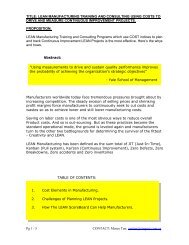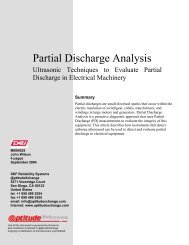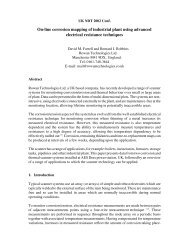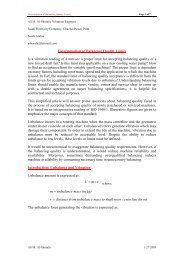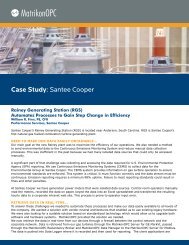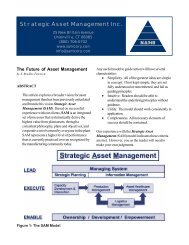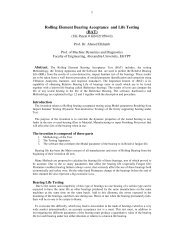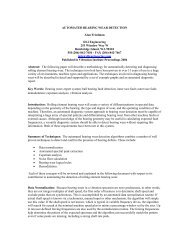A Re-Examination of Failure Analysis and Root Cause Determination
A Re-Examination of Failure Analysis and Root Cause Determination
A Re-Examination of Failure Analysis and Root Cause Determination
- No tags were found...
Create successful ePaper yourself
Turn your PDF publications into a flip-book with our unique Google optimized e-Paper software.
A <strong>Re</strong>-<strong>Examination</strong> <strong>of</strong> <strong>Failure</strong> <strong>Analysis</strong> <strong>and</strong> <strong>Root</strong> <strong>Cause</strong> <strong>Determination</strong>M. Zamanzadeh, E. Larkin <strong>and</strong> D. GibbonMatco AssociatesPO Box 15580Pittsburgh, Pennsylvania 15244412-788-1263December 2004<strong>Failure</strong> analysis is a complex process applied to all different types <strong>of</strong> materials.Each class <strong>of</strong> materials requires special skills <strong>and</strong> experience to effectivelyunravel the causes <strong>of</strong> failure. This is the first in a series <strong>of</strong> papers focusing onthese various subsets <strong>of</strong> materials. The series will include failures in metallurgy,paints <strong>and</strong> coatings, plastics <strong>and</strong> electronics, as well as failure caused bycorrosion. Each paper in the series will also include an examination the principles<strong>of</strong> root cause determination within that particular field. This first paper isprimarily concerned with the overall approach to failure analysis <strong>and</strong> with theapplications <strong>of</strong> that approach to metallurgical failures.
2TABLE OF CONTENTSPart 1: FAILURE ANALYSIS – A CONCEPTUAL FRAMEWORKI. Introduction<strong>Failure</strong>s Are <strong>Cause</strong>d by Human ErrorsProduct Specifications <strong>and</strong> <strong>Failure</strong><strong>Root</strong>-<strong>Cause</strong> <strong>Determination</strong> DefinedV. How to Conduct a <strong>Failure</strong> <strong>Analysis</strong>Determine when, where <strong>and</strong> how the failure occurredCollect samples for laboratory examinationTake on-site photographsVisually examine the sampleIdentify defects Non-DestructivelyConduct appropriate chemical analysesConfirm material composition <strong>and</strong> identify contaminants through EDS analysisAnalyze via FractographyAnalyze via MetallographyDetermine the cause <strong>of</strong> failurePhysical TestingFinite Element <strong>Analysis</strong>3. Fracture Mechanics11.Types <strong>of</strong> <strong>Failure</strong>s1. Ductile FractureBrittle FractureFatigue fracture. 12. Synthesize <strong>and</strong> summarize the data, determine <strong>and</strong>report the root-cause <strong>of</strong> the failurePart 2: CASE STUDIES IN MATERIALS FAILURE ANALYSISCase History #1. Onsite Metallography <strong>of</strong> Structural SteelCase History #2. <strong>Failure</strong> <strong>Analysis</strong> <strong>of</strong> a Conveyor Drive ShaftCase History #3. Metallurgical <strong>Failure</strong> <strong>Analysis</strong> <strong>of</strong> A Welded Hydraulic CylinderCase History #4. Aircraft Component <strong>Failure</strong> <strong>Analysis</strong>Case History #5. Cap Screw Assembly <strong>Failure</strong>Case History #6. Aircraft Engine <strong>Failure</strong>APPENDIX A: Summary <strong>of</strong> Fracture Mechanics Applications to <strong>Failure</strong> <strong>Analysis</strong>
3I. IntroductionThe purpose <strong>of</strong> failure analysis is entirely positive: to prevent further failures. <strong>Failure</strong>soccur when some system or part <strong>of</strong> a system fails to perform up to the expectations forwhich it was created. A transmission fails. A pipeline leaks. A cell phone explodes. Theconcept <strong>of</strong> failure is easy to underst<strong>and</strong> intuitively. But underneath that intuitiveunderst<strong>and</strong>ing are important conceptual principles which are commonly eithermisunderstood or not considered at all.<strong>Failure</strong> itself is a human concept. Materials do not fail in <strong>and</strong> <strong>of</strong> themselves. They followthe laws <strong>of</strong> nature perfectly. If a part is loaded beyond its tensile strength, it breaks.Until that stress level is reached, it does not break. When a part fails in service, it wasunder-designed or poorly manufactured for the circumstances in which it was used.II. <strong>Failure</strong>s Are <strong>Cause</strong>d by Human ErrorsThat being understood, then all failures are caused by human errors, <strong>of</strong> which there arethree general types:a) Errors <strong>of</strong> knowledgeb) Errors <strong>of</strong> performance (which might be caused by negligence), orc) Errors <strong>of</strong> intent (which may come down to acts <strong>of</strong> greed)What are <strong>of</strong>ten called “acts <strong>of</strong> God” are more or less widely spaced natural events, suchas the flooding associated with unusually large storms, earthquakes, <strong>and</strong> so forth. Interms <strong>of</strong> geologic time rather than the very short human experience, these events arecertainties, not exceptions. They will happen, given enough time. <strong>Failure</strong>s associatedwith “acts <strong>of</strong> God” are, again, the results <strong>of</strong> under-design for the actual conditions thecomponent or system faces in service.Errors <strong>of</strong> knowledge usually involve insufficient knowledge, education, training,<strong>and</strong>/or experience. Here are a few examples <strong>of</strong> such errors <strong>of</strong> knowledge– Ancient Romans used lead in their wine goblets. Using them over longperiods produced lead poisoning <strong>and</strong> ultimately insanity. 19 th centuryArctic explorers repeated this failure in their food containers.– Dendrite growth on metals in conductive ionic environments producesshort circuits in electronic components for computers.– Hydrogen Embrittlement (HE) causes otherwise stable high strength steelcomponents to fail.– Degassing produces bubbles <strong>and</strong> ultimately corrosion in coated cast ironpipes.– Internal <strong>and</strong> external corrosion <strong>of</strong> gas lines in the early 20th centurycaused frequent urban explosions.– NASA Shuttle disasters involved both O-ring <strong>and</strong> ceramic insulationfailures.
4Errors <strong>of</strong> performance result from lack <strong>of</strong> sufficient care or from negligence.Negligence involves such things as misreading <strong>of</strong> drawings, inadequatespecifications, <strong>and</strong> defective manufacturing <strong>and</strong> workmanship. Some examplesare:– <strong>Re</strong>cent NASA failures in a Mars mission involved the incorrect conversionfrom the English to the Metric System <strong>of</strong> measurement in a computerprogram.– The Chernobyl Nuclear Power Plant accident involved a major failure indesign <strong>of</strong> the safety system.– <strong>Failure</strong>s in Human Breast Implants involve an insufficiently durablepackaging for the silicone materials <strong>of</strong> which the implants were made.– Explosions <strong>of</strong> natural gas have been caused by the spark from a car’signition being started next to a leaking pipe line..Errors <strong>of</strong> intent very commonly involve greed. Greed leads to actions usuallycarried out with a conscious or unconscious denial <strong>of</strong> full knowledge <strong>of</strong> thepotential consequences. In other words, the perpetrators convince themselvesthat their actions will not have serious impacts. For example:– Cost reduction driving design <strong>of</strong> military vehicles causing prematurefailures.– Exxon Valdez <strong>and</strong> many other oil tanker spills were caused by usingsingle hulls in super tankers.– Aloha stadium superstructure corrosion failures were caused by lack <strong>of</strong>surface preparation <strong>and</strong> poor materials <strong>and</strong> coating selection.– <strong>Failure</strong> <strong>of</strong> bonding <strong>of</strong> steel belts in Firestone radial tires on Ford SUV’scaused many roll-over accidents.An interesting example <strong>of</strong> combining various types <strong>of</strong> errors is found in the production <strong>of</strong>galvanized steel. Since the 1930s it has been known that introduction <strong>of</strong> approximately0.15% <strong>of</strong> aluminum into a hot-dip galvanizing bath will cause the formation <strong>of</strong> a thinaluminum-iron-zinc intermetallic layer at the steel surface. This intermetallic layer actsas a barrier to iron migration into the zinc, preventing the formation <strong>of</strong> brittle iron-zincintermetallics. With this al-fe-zn layer in place, when the galvanized component is bentduring service, the zinc layer deforms plastically, rather than fracturing. Whenmanufacturers experience high rates <strong>of</strong> cracking in their galvanizing layers, they have<strong>of</strong>ten let the aluminum concentration in their galvanizing bath slip out <strong>of</strong> control.This failure may be a combination <strong>of</strong> all three kinds <strong>of</strong> errors. The manufacturer maysimply not know that the aluminum concentration is so vital to the success <strong>of</strong> hisproduct, he may just be letting his quality control function slip out <strong>of</strong> negligence, or hemay be unwilling to spend the money necessary to mount an effective quality controlprogram in his plant.We will refer back to this example below when we discuss “root cause” determination inSection IV below.
5These ideas provide the philosophical underpinnings for a study <strong>of</strong> failures. It isimportant to recognize that many failures are preventable if we underst<strong>and</strong> thematerials <strong>and</strong> their intended applications well enough <strong>and</strong> are willing to pay the requiredcosts for safety <strong>and</strong> durability.III. Product Specifications <strong>and</strong> <strong>Failure</strong>The service-life-expectancy <strong>of</strong> a product is defined by the level <strong>of</strong> degradation that willbe designated as failure. This would ideally be found in a product specification orwarranty, a document which summarizes product quality requirements, desiredoutcomes, <strong>and</strong> expectations. A product specification may include requirements that theproduct meet certain accepted st<strong>and</strong>ards such as those defined by ASTM, NACE, orother self-regulatory bodies. A well–written specification indicates such characteristicsas load-bearing capacity <strong>and</strong> life expectancy.Many specifications recognize that perfect materials do not exist. Major constructioncodes may do the same thing. They make allowance for the presence <strong>of</strong> defects orcorrosion loss by establishing limits on defect type, size, location, <strong>and</strong> distribution.Imperfections such as surface laps, tears <strong>and</strong> casting <strong>and</strong> forging defects arerecognized in ASME <strong>and</strong> AFS materials specifications as acceptable within certainlimits. However, in the real world <strong>of</strong> MATCO’s investigations it has been found thatspecifications or st<strong>and</strong>ards have commonly not been put in place prior to putting aproduct in service. Having such specifications would provide a valuable reference guideshould a product fail in service, helping the analyst determine whether the failure wasreasonably to be expected.For example, recently a widely used type <strong>of</strong> aluminum scaffolding collapsed in service.The owner wanted to know if he had a cause <strong>of</strong> action against the manufacturer. Theproduct had been in service for over five years, three <strong>of</strong> which had been under a priorowner. A full failure analysis found no defect in the product <strong>and</strong> found it fully within thespecifications. Apparently the product simply wore out <strong>and</strong> finally failed. It may havesuffered overload under the prior ownership, but that was unknowable. Themanufacturer was protected by the load-limit specifications <strong>and</strong> by the finding <strong>of</strong> nomanufacturing or material defects.In another example, a small area <strong>of</strong> discoloration in the paint <strong>of</strong> an expensive new carmay be considered unacceptable because <strong>of</strong> the desired high quality <strong>of</strong> appearance. Bycontrast, pinholes <strong>of</strong> various sizes through epoxy coatings on gas lines may not beconsidered unacceptable, because corrosion <strong>of</strong> the pipeline in service will be preventedby cathodic protection. Corrosion resistance is the issue <strong>of</strong> greatest importance for thepipeline, not appearance, Thus the criteria for failure are quite different, even thoughcoating quality is an important issue in both cases.The service-life-expectancy must always be tailored to the product application. Forexample, most coating specifications are designed for products to be used for abovegroundcorrosion protection. Few <strong>of</strong> these specifications are particularly relevant tounderground coating applications where cathodic protection may be in place.
6IV. <strong>Root</strong> <strong>Cause</strong> <strong>Determination</strong>The main concern in every business is customer satisfaction. When a product does notlive up to its design expectancy, i.e., when it fails either gradually, suddenly, orcatastrophically, a method <strong>of</strong> evaluation must be available to underst<strong>and</strong> why the failureoccurred. <strong>Root</strong>-cause failure analysis provides this underst<strong>and</strong>ing. Fully implemented,it seeks not only to solve the immediate problem, but to provide valuable guidance toavoid the problem in the future.The primary cause is the set <strong>of</strong> conditions or parameters from which the failure began.The old saying, “For want <strong>of</strong> a nail the shoe was lost, for want <strong>of</strong> a shoe the horse waslost, for want <strong>of</strong> a horse the battle was lost, for want <strong>of</strong> the battle the kingdom was lost,”summarizes a classic primary cause determination. The analyst must discover what itwas about this incident that is fundamentally responsible for the failure in performance<strong>and</strong> determine the sequence <strong>of</strong> events that led to the final failure.By contrast, the root cause <strong>of</strong> a failure is a process or procedure which “went wrong.”The finish on a machine part was not as-specified. The heat-treatment on a rail was notuniform. The angle on screw-threads was too steep. Identification <strong>of</strong> that process is thekey to creating a procedure by which future failures can be avoided.Most failure analysis stops short <strong>of</strong> this final step. Instead what is presented to the clientis the primary cause <strong>of</strong> failure. The poor finish, the incorrect heat treatment, the shape<strong>of</strong> the screw threads in the paragraph above are the “primary causes’ <strong>of</strong> those failures,not the root causes. The root causes would be:• the failure to check the finish after the part was machined,• the failure to ensure that the heat treatment furnace had sufficient control <strong>of</strong>changes in temperature to produce the desired microstructure in the rails, or• The failure to enter the proper information into the thread-cutting process.• The horse’s groom not checking to see that the horse’s shoes were properlynailed on before sending him into battle.All four <strong>of</strong> these were “process” or “procedure” failures.In the example presented in Section II on problems in hot-dip galvanizing <strong>of</strong> steel, theprimary cause <strong>of</strong> cracking <strong>of</strong> galvanized steel in bending may be the lack <strong>of</strong> analuminum-iron-zinc intermetallic layer at the steel surface. But the root cause is thefailure to maintain the aluminum level in the galvanizing bath.To avoid these same failures in the future, to determine the root cause <strong>of</strong> the failure, theprimary cause must be supplemented by intimate underst<strong>and</strong>ing <strong>of</strong> the entire history <strong>of</strong>the failed system or part, including both its manufacturing <strong>and</strong> its use. This informationis usually most effectively obtained by visiting the manufacturing site for the failed part.From this information a new procedure can be crafted which will prevent repetition <strong>of</strong>the original failure.
7V. How to conduct a failure analysisA failure analysis is much like the work <strong>of</strong> a detective. Important clues are discoveredthroughout the investigation that provide insight into what may have caused the failure<strong>and</strong> what contributing factors may have been involved. The failure analyst is aided by abroad knowledge <strong>of</strong> materials in general. Success is more likely if the analyst is aware<strong>of</strong> the failed material’s mechanical <strong>and</strong> physical properties <strong>and</strong> its fabrication <strong>and</strong>historical performance characteristics. The analyst must also possess a workingknowledge <strong>of</strong> structural design <strong>and</strong> stress behavior.A component is considered to have failed when it has deteriorated to the point at whichit is unsafe or only marginally capable <strong>of</strong> performing its intended function. For an item tobe classified as a failure it need not be completely broken. As an illustration, consider afracture as a type <strong>of</strong> failure. Fractures occur in materials when cracks are initiated <strong>and</strong>propagate to a greater or lesser degree. They may not go to completion. Cracks maybe initiated by mechanical stresses or environmental- or chemical-influences, by theeffects <strong>of</strong> heat, by impurities in the material or by a combination <strong>of</strong> these <strong>and</strong> manyother factors. Underst<strong>and</strong>ing the relative importance <strong>of</strong> those factors in the specific caseat h<strong>and</strong> is the job <strong>of</strong> the failure analyst.For the purposes <strong>of</strong> this paper, the metallurgical aspects <strong>of</strong> materials will beemphasized in the illustrations. Other types <strong>of</strong> failures will be considered in latersegments <strong>of</strong> the overall publication.1. Preliminaries. Determine when, where <strong>and</strong> how the failure occurred.Before beginning any failure analysis, it is vital to determine whether or not destructivetesting is permitted or if the testing must be limited to non-destructive approaches. If thefailure is or may be subject to litigation, opposing counsels must agree on this pointbefore any sampling begins. Witnessed testing (the presence <strong>of</strong> parties from both sidesin a law suit) may be called for.It is important to visit the failure site in the field if possible. All operators involved in thefailure should be interviewed personally. Determine what the conditions were at thetime <strong>of</strong> failure. Were there prior indications suggesting failure was about to occur? Wasthe failure gradual or catastrophic? Was the part protected after failure? How was thefracture h<strong>and</strong>led? Did the failure involve any fire or other condition which could havealtered the microstructure <strong>of</strong> the base metal or <strong>of</strong> some part <strong>of</strong> the sample such as aweld? These <strong>and</strong> all other appropriate questions should provide a basis for theinvestigation.It may be important to obtain documentation on maintenance procedures during thelifetime <strong>of</strong> the equipment that failed including, if applicable, maintenance personnel,records <strong>of</strong> scheduled maintenance, <strong>and</strong> suppliers <strong>and</strong> products used.
8As a part <strong>of</strong> this preliminary information gathering, it is also important to obtain thephysical <strong>and</strong> chemical specifications for the product which failed, against whichperformance may be measured.2. Collect samples for laboratory examination. Samples selected should becharacteristic <strong>of</strong> the material <strong>and</strong> contain a representation <strong>of</strong> the failure or corrosiveattack. For comparative purposes, a sample should also be taken from a sound <strong>and</strong>normal section.Sampling h<strong>and</strong>ling is a paramount issue on which the whole remaining analysisdepends. Fracture surfaces must be protected from damage during shipment byrigorously careful packaging. Surfaces should not be touched, cleaned or put backtogether. .Surface chemistry must not be contaminated by careless h<strong>and</strong>ling.Materials specifications <strong>and</strong> service history reveal much about the nature <strong>of</strong> failure. Ifsubmitting a sample for analysis background information will need to be provided. Asample form that we find helpful is shown on the following page. Take copious notes.Do not rely on memorySamples can be removed by acetylene torch, air-arc, saw, trepan, or drill. All cuts withan acetylene torch should be made at least six inches <strong>and</strong> cuts by air-arc at least fourinches away from the area to be examined to avoid altering the microstructure orobscuring corrosive attack.If pipe failures are involved, careful observation <strong>of</strong> the pipe conditions is important bothprior to sample removal <strong>and</strong> as the cut separates the two ends <strong>of</strong> the pipe, as thosemay indicate stress conditions in the pipe at the time <strong>of</strong> failure. All <strong>of</strong> thesecharacteristics should be noted <strong>and</strong> documented photographically. Be careful to includein the samples any failure-related materials such as coatings, soils in which a pipe mayhave been buried, corrosion deposits, waters, etc.It is vital to prevent liquid samples from going septic. If bacterial content is a potentiallyimportant issue the samples must be taken in clean containers, refrigerated <strong>and</strong>delivered to microbiological labs for culturing within 24 hours. If bacterial content isirrelevant to the study, then two drops <strong>of</strong> household bleach per quart <strong>of</strong> sample willsterilize the contents. Note that the bleach addition will change the sodium <strong>and</strong> chlorinecontents <strong>of</strong> the samples. A detailed knowledge <strong>of</strong> the final purpose for the samples hasto control how they are to be h<strong>and</strong>led.3. Take on-site photographs. Photographs should be taken <strong>of</strong> the failed piece <strong>of</strong>equipment including the samples to be removed <strong>and</strong> their surroundings. These shouldshow the relationship <strong>of</strong> the questioned area to the remainder <strong>of</strong> the piece <strong>of</strong> equipment.Additional photos should be taken <strong>of</strong> the samples after removal to fully identify them. Ifmore than one sample is to be taken, proper designation <strong>of</strong> the sample <strong>and</strong> its locationrelative to the piece <strong>of</strong> equipment should be noted. The dimensions <strong>of</strong> the sample, thedate the failure occurred, <strong>and</strong> the date <strong>of</strong> the photographs should be noted. Considerthe use <strong>of</strong> video recording if complex disassembly is required
94. Visually examine the sample. Examine the sample with unaided eye, h<strong>and</strong> lens<strong>and</strong>/or low magnification field microscopes. Note the condition <strong>of</strong> the accessible surfacedocumenting all sorts <strong>of</strong> anomalies, searching for cracks, corrosion damage, thepresence <strong>of</strong> foreign material, erosion or wear damage, or evidence <strong>of</strong> impact or otherdistress. Also consider the condition <strong>of</strong> protective coatings. Manufacturing defects areimportant.If pipe failure is involved, it is important to carefully measure wall thicknesses both at thefailure site <strong>and</strong> some distance away from it at four locations 90 degrees apart aroundthe pipe circumference, starting a the failure site. At the same time note the presence <strong>of</strong>any corrosion <strong>and</strong> map its general distribution.5. Identify defects Non-Destructively. Search for material imperfections withradiography, magnetic particle, ultrasonic, liquid/dye penetrant, eddy current, leak,<strong>and</strong>/or acoustic emissions non-destructive testing procedures. Some photographicexamples <strong>of</strong> these techniques are provided below.At Left: Magnetic Particle Testing done by inducing a magneticfield in a ferro-magnetic material <strong>and</strong> dusting the surface withiron particles. Above Center: Radiography. Above Right:Fluorescent Liquid Dye Penetrant viewed in black light.6. Conduct appropriate chemical analyses. Chemical analysis should be conductedon the original material to determine if the material was <strong>of</strong> proper type <strong>and</strong> grade,whether it met appropriate st<strong>and</strong>ards, <strong>and</strong> whether deviation from the specificationscontributed to the fracture, wear, breaks corrosion <strong>and</strong> failure. Wet chemical analysis,Atomic Absorption, X-ray Photoelectron, Auger Electron <strong>and</strong> Secondary Ion MassSpectroscopies are all potentially suitable methods <strong>of</strong> chemical analysis, depending onthe particular need <strong>of</strong> the situation. The techniques differ in important ways. Other parts<strong>of</strong> the failure “system” may also require analysis, including corrosion products, coatings<strong>and</strong> liquids.
10SEMIntensLeft & Below: Line scanningisolates an area <strong>of</strong> the specimen.The red line indicates the location<strong>of</strong> the scan.CC5000 200 400FeFeIntens2001501000 200 400IntensCr150100500 200 400Intens20CrNiNi0 200 4007. Confirm material composition <strong>and</strong> identify contaminants through EDS analysis.EDS (Energy-Dispersive Spectroscopy) is an analytical method based on thedifferences in energy <strong>of</strong> the characteristic x-rays emitted by the various elements. It isused in conjunction with scanning electron microscopy (SEM) to identify the elementspresent at a particular spot on a sample. Advantages <strong>of</strong> EDS are that it is easilyperformed <strong>and</strong> is reliable as a qualitative method. Limitations are that it is onlymarginally useful as a quantitative method.8. Analyze via Fractography, Fractography is used to determine the mode <strong>of</strong> fracture(intergranular, cleavage, or shear), the origin <strong>of</strong> fracture, <strong>and</strong> location <strong>and</strong> nature <strong>of</strong>flaws that may have initiated failure. With this information, the answer as to why a partfailed can usually be determined. The major use <strong>of</strong> fractography is to reveal therelationship between physical <strong>and</strong> mechanical processes involved in the fracturemechanism. The size <strong>of</strong> fracture characteristics range from gross features, easily seenwith the unaided eye, down to minute features just a few micrometers across.Light <strong>and</strong> electron microscopy are the two more common techniques used infractography. An important advantage <strong>of</strong> electron microscopy over conventional lightmicroscopy is that the depth <strong>of</strong> field in the SEM is much higher; thus the SEM can focuson all areas <strong>of</strong> a three-dimensional object identifying characteristic features such asstriations or inclusions.The texture <strong>of</strong> a fracture surface, that is, the roughness <strong>and</strong> the color, gives a goodindication <strong>of</strong> the interactions between the fracture path <strong>and</strong> the microstructure <strong>of</strong> thealloy. For instance, at low stress a fatigue fracture is typically silky <strong>and</strong> smooth inappearance. Stress corrosion fractures show extensive corrosion features <strong>and</strong> corrosion“beach marks.” A discontinuous ductile fracture shows some stages <strong>of</strong> crack tipblunting, crack arrest <strong>and</strong> "pop-in".9. Analyze via Metallography. Prepare a laboratory specimen with care not to removeinclusions, erode grain boundaries or compromise the sample in some other way. Studystructural characteristics in relation to its physical <strong>and</strong> mechanical properties at low <strong>and</strong>
11high magnification. Take careful note <strong>of</strong> grain size, shape, <strong>and</strong> distribution <strong>of</strong> secondaryphases <strong>and</strong> nonmetallic inclusions. Segregation <strong>and</strong> other heterogeneous conditionsalso influence the mechanical properties <strong>and</strong> behavior characteristics <strong>of</strong> metal.At Far Left: IntergranularStress Corrosion Cracking(ISCC) in turbine componentAt Left: Cross-section <strong>of</strong>copper lance componentexposed to excessivetemperatures showing graingrowth.Metallography for the analyst may be concerned with pit depth, intergranular corrosion,hydrogen attack <strong>and</strong> embrittlement, caustic embrittlement, stress corrosion cracking(intergranular or transgranular), <strong>and</strong> corrosion, mechanical or thermal fatigue. Also,within limits, an almost complete history <strong>of</strong> the mechanical <strong>and</strong> thermal treatmentreceived by a metal is reflected in its microstructure.10. Conduct Appropriate Mechanical <strong>and</strong> Materials Testing <strong>and</strong> <strong>Analysis</strong> asNecessary1. Physical TestingIt may be necessary to conduct physical tests to determine if the mechanical properties<strong>of</strong> the materials involved conform to specifications. Hardness, tensile strength, impact,fatigue resistance, wear, flexibility <strong>and</strong> many other physical tests are relatively common.These tests <strong>of</strong>ten compare the material in the failed component with st<strong>and</strong>ards. Testspecimens for determination <strong>of</strong> mechanical properties should not be taken from areas <strong>of</strong>the component that have been plastically deformed during the failure.In general, structural members <strong>and</strong> machine parts can fail to perform their intendedfunctions by:• excessive elastic deformation (deflection under applied loads),• yielding (permanent material deformation as a result <strong>of</strong> stress), or• fracture.For instance, the deflection <strong>of</strong> closely mating machine parts due to surface stresses(elastic deformation) can degrade adjacent parts by increasing wear <strong>and</strong> in certaincases can promote complete failure. A study <strong>of</strong> the mechanical properties <strong>of</strong> the partscan provide information on load-bearing capabilities <strong>of</strong> the system <strong>and</strong> can minimizesuch failures.
122. Finite Element <strong>Analysis</strong>The finite element method is a powerful numerical tool for analyzing mechanicalcomponents <strong>and</strong> systems. The representation <strong>of</strong> a component or systemmathematically with finite elements generally involves a discretization <strong>of</strong> the structureinto many small pieces, e.g. small brick-like elements (hence the name <strong>of</strong> the method).The solution to the equations that govern the behavior <strong>of</strong> the structure is approximatedon each <strong>and</strong> every brick. The collective effect <strong>of</strong> all the bricks is taken into accountduring a step that synthesizes the solutions for each brick into one solution valid for theentire structure. This global solution represents the solution to the equations that governthe structure's behavior.The finite element method provides a tool to predict <strong>and</strong> evaluate component response,elastic or non-linear plastic, subjected to thermal <strong>and</strong> structural loads. Thermal analysesmay include convection, conduction, <strong>and</strong> radiation heat transfer, as well as variousthermal transients <strong>and</strong> thermal shocks. Structural analyses may include all types <strong>of</strong>constant or cyclic loads, mechanical or thermal, along with non-linearities, such asopening/closing <strong>of</strong> contact surfaces, friction, <strong>and</strong> non-linear material behavior. Finiteelement analysis can be used during a failure study in such ways as:• Predicting the response <strong>of</strong> an existing component or assembly to stress• Assessment <strong>of</strong> remaining life <strong>of</strong> a component or assembly• Determining the failure mode <strong>of</strong> a failed component or assembly, e.g. fatigue,creep, <strong>and</strong> buckling.• Designing <strong>of</strong> a new component or assembly as a part <strong>of</strong> recommendations forremediation <strong>of</strong> the problem3. Fracture MechanicsUsing the many analytical techniques above will help to determine how the part inquestion actually failed, what the mode <strong>of</strong> failure was <strong>and</strong> where the failure wasinitiated. What is missing is a quantitative idea <strong>of</strong> the stress environment in the failure<strong>and</strong> the response <strong>of</strong> the failed part to that stress. The relatively new science <strong>of</strong> fracturemechanics can provide a quantitative framework within which the failure may beunderstood.Fracture mechanics relates the size <strong>of</strong> flaws in a material, principally cracks, to theapplied stresses on those cracks <strong>and</strong> to the “fracture toughness” <strong>of</strong> the material, or itsresistance to cracking.Fractures include both initiation <strong>and</strong> growth phases. After initiation, perhaps at a pit orsome other site <strong>of</strong> stress-concentration, the crack will only grow when the stresses atthe crack tip exceed a critical value known as the “fracture toughness” or K Ic . If K Ic <strong>and</strong>
13the stress conditions are known for a given material, then it is possible to calculate thesize <strong>of</strong> crack that can be tolerated in that material without having the crack grow further.The following equation shows those conditions. A crack will propagate if:σ≥βKIcπ awhere σ (sigma) is the fracture stress, β (beta) is a dimensionless shape factor <strong>and</strong> a isthe crack length for a crack with only one tip (i.e., not an internal crack, but one openingat a surface). H<strong>and</strong>books for engineering calculations have tables <strong>of</strong> values for Beta fordifferent geometries.If the fracture toughness <strong>of</strong> the material is known, the fracture stress or critical cracksize <strong>of</strong> a component can be calculated if the stress intensity factor is known.This calculation will allow• the determination <strong>of</strong> “permissible flaw size,”• the calculation <strong>of</strong> the stress necessary to cause catastrophic failure• the determination <strong>of</strong> the load on a component at the time <strong>of</strong> failure• the determination as to whether adequate materials were used in manufacturing• the determination as to whether a part design was adequate.If the system that failed is well documented, then operational stresses can becalculated. For example, it can be determined how great the load was on a certain partwhen it failed. The load history may also be known throughout the time that the part wasused. These data can be used to calculate the toughness, given a knowledge <strong>of</strong> thecrack size at the time <strong>of</strong> final failure. This will show whether the part performedaccording to the specifications for it.On the other h<strong>and</strong>, if the stresses are not known, then toughness still can be estimatedfrom materials h<strong>and</strong>books, again knowing the crack size <strong>and</strong> the area <strong>of</strong> the remainingsound metal at the time <strong>of</strong> failure.If neither toughness nor stresses are known, toughness can be estimated from physicaltesting, using Charpy-impact tests on pieces <strong>of</strong> the material. The stresses at failure canbe determined by back-calculation <strong>and</strong> it can then be said if the part failed fromoverload.Much can be also done to quantify conditions from fatigue failures. The rate <strong>of</strong> crackgrowthcan be estimated from a knowledge <strong>of</strong> the number <strong>of</strong> striations per unit length <strong>of</strong>crack perpendicular to the crack front. If the stresses are known, the stress intensity canbe inferred, <strong>and</strong> the adequacy <strong>of</strong> the material for the use conditions can be determined.From a knowledge <strong>of</strong> the known stresses, the crack size at fracture <strong>and</strong> the crackgrowth-rate, estimates may be made as to whether or not the material had beenmisused.
14Thus, fracture mechanics can be used to help us underst<strong>and</strong>• how a particular crack formed at a specific location <strong>and</strong>• the stress conditions that caused the crack to propagate.The design engineer will normally include “factors <strong>of</strong> safety” in his design to preventstresses from reaching critical levels .More detailed examples <strong>of</strong> the applications <strong>of</strong> Fracture Mechanics to failure analysis aregiven in Appendix A.11. Determine the type <strong>of</strong> failureThe major types <strong>of</strong> failures likely to be encountered by metals in service are:A. Ductile,B. Brittle, <strong>and</strong>C. Fatigue fracturesWear, Fretting, Elevated Temperature <strong>and</strong> Corrosion are other important causes <strong>of</strong>failure which will be covered in a future publication in this series.A. Ductile Fracture1920xDuctile fractures are characterized by tearing <strong>of</strong> metal accompanied by appreciablegross plastic deformation. The microstructure <strong>of</strong> the fracture surface is quite complex<strong>and</strong> may include both transgranular <strong>and</strong> intergranular fracture mechanisms. Ductilefractures in most metals have a gray fibrous appearance <strong>and</strong> may be flat-faced (tensileoverload) or slant-faced (shear). The specimen usually shows considerable elongation<strong>and</strong> possible reduction <strong>of</strong> cross-sectional area as well. Whether a part fails in a ductileor brittle fashion depends on the thickness <strong>of</strong> the part, temperature, strain rate <strong>and</strong> thepresence <strong>of</strong> stress-raisers. Most commonly seen characteristics <strong>of</strong> ductile failures are:• Lateral contraction, or necking;• Fracture path in the interior following a generally flat plane perpendicular to theprincipal stress direction, <strong>and</strong>
15• Tensile stress.Cylindrical specimens will have a “cup <strong>and</strong> cone” configuration, as shown above on theright, while the fracture surface on thick specimens will be generally perpendicular to theprincipal stress direction, as seen in the bolt in the illustrations above.B. Brittle Fracture835xPipe ExplosionBrittle fractures are characterized by rapid crack propagation without appreciable plasticdeformation. If brittle fractures occur across particular crystallographic planes they arecalled Tran crystalline fracture. If along grain boundaries they are called intergranularfracture. Brittle fracture is promoted by:• thicker section sizes,• lower service temperatures, <strong>and</strong>• increased strain rate.A material’s tendency to fracture in a brittle mode can be determined by measuring itsnotch ductility. The most common test for this is the Charpy V-notch test. <strong>Failure</strong> undertest condition can exhibit energy <strong>and</strong> fracture transitions. Shear fracture occurs underthe notch <strong>and</strong> along the free surfaces. Cleavage fracture occurs in the centercharacterized by a bright, shiny, faceted surface. 50% cleavage is the fracturetransition point. Cleavage fracture is caused by inability <strong>of</strong> the crystal structure to crossslip.Yield strength loading is required to initiate a brittle fracture; however, only muchlower stress may be needed to propagate it. Generally speaking, body-centered cubicmetals exhibit a ductile to brittle transition over a relatively narrow temperature range.The Drop Weight Test defines the nil-ductility transition temperature <strong>and</strong> is very usefulfor determining the brittle fracture susceptibility <strong>of</strong> low-strength steels. Linear elasticfracture mechanics evaluates structural reliability in terms <strong>of</strong> applied stress, crack length<strong>and</strong> stress intensity at the crack tip.7960
16C. Fatigue fractureFatigue is a progressive localized permanent structural change that occurs in a materialsubjected to repeated or fluctuating stresses well below the ultimate tensile strength(UTS). Fatigue fractures are caused by the simultaneous action <strong>of</strong> cyclic stress, tensilestress, <strong>and</strong> plastic strain, all three <strong>of</strong> which must be present. Cyclic stress initiates acrack <strong>and</strong> tensile stress propagates it. Final sudden failure <strong>of</strong> the remaining crosssectionoccurs by either shear or brittle fracture. Striations on the crack surface are theclassic sign <strong>of</strong> fatigue fracture.High Cycle FatigueLow Cycle FatigueFatigue cracks may start because<strong>of</strong> tool marks, scratches,indentations, corrosion pits <strong>and</strong>areas <strong>of</strong> high stress. At the cracktip, the material is plastic. At asmall distance from the crack tip,in the material is elastic.Low cycle fatigue cracks occur under conditions <strong>of</strong> high strain amplitude (with failure inless than about 10 4 cycles) whereas high cycle fatigue occurs with low strainamplitude with failure after a large number <strong>of</strong> load fluctuations. In low cycle fatigue,striations, if visible at all, tend to be rather broad, widely spaced, <strong>and</strong> discontinuous inplaces. Areas without striations may appear to be rubbed or may be quite featureless,except for the area <strong>of</strong> final fracture. In high cycle fatigue, the striations will be welldefined <strong>and</strong> more closely spaced, with propagation evident in many flat plateaus thatare joined by narrow regions <strong>of</strong> tensile tearing. The investigator should be aware,however, that in heat-treated steels striations are absent from fatigue fractures more<strong>of</strong>ten than they are observed, <strong>and</strong> the stronger (harder) the steel, the less likely it is thatstriations will be observable. Thus, suspected fatigue striations must be studiedcarefully to ensure that they are not artifacts <strong>of</strong> some other process. Striations shouldbe parallel to one another along their lengths <strong>and</strong> perpendicular to the fracture directionat the region being examined.Thermal Fatigue cracking is caused by cycling the temperature <strong>of</strong> the part in thepresence <strong>of</strong> mechanical constraint, e.g., rigid mounting <strong>of</strong> pipe. It could also be causedby temperature gradients in the part.
17Contact Fatigue - Elements that roll, or roll <strong>and</strong> slide against each other under highcontact pressure are subject to the development <strong>of</strong> surface pits or fatigue spalls aftermany repetitions <strong>of</strong> load.Corrosion pit acting as stressconcentrator for fatigue crack (onleft at low magnification. Higher42 1 33magnification <strong>of</strong> crack tip on right.12025x2150xCorrosion-Fatigue is caused by the combined action <strong>of</strong> repeated or fluctuating stress<strong>and</strong> a corrosive environment to produce failure. It frequently initiates at a corrosion piton the surface. A very aggressive environment may actually slow the fatigue fractureprocess increasing the number <strong>of</strong> stress cycles to failure. The environment affects thecrack growth rate, or the probability <strong>of</strong> fatigue crack initiation, or both. Test data showthat for high strength steels, the fatigue strength at 10 million cycles in salt water can bereduced to as little as 10% <strong>of</strong> that in dry air. Carbon steels exhibit transgranularfracture. Copper <strong>and</strong> its alloys fail by intergranular fracture.12. Synthesize <strong>and</strong> summarize the data, determine <strong>and</strong> report the root-cause <strong>of</strong>the failure. Proposed root causes <strong>of</strong> a failure must be based primarily on observedfacts. These facts, combined with the experience, skill <strong>and</strong> knowledge <strong>of</strong> the analyst willlead to sound conclusions.All the observed data should be reported, even if some <strong>of</strong> it seems peripheral. In thefuture, with additional data, it may turn out to be possible to use what seemed peripheralat first to make an even more sound interpretation.
18Part 2: CASE STUDIES IN MATERIALS FAILURE ANALYSISThe following case histories present a wide range <strong>of</strong> applications <strong>of</strong> the techniques forfailure analysis outlined in the fore-going protocol. They are selected from the hundreds<strong>of</strong> cases that have passed through the authors’ laboratories over the past thirty years.Case History #1 On-Site Metallography <strong>of</strong> Structural SteelA large crack <strong>and</strong> several smaller cracks were discovered in one flange <strong>of</strong> a steelcolumn in a large new stadium. The H-section column was made <strong>of</strong> ASTM A572 grade50 high-strength, low-alloy steel, a common structural material in welded, bolted orriveted structures such as buildings <strong>and</strong> bridges. Such a crack is considereddetrimental to the service life <strong>of</strong> the material <strong>and</strong> if left untreated, the crack couldpropagate under adverse conditions.An on-site metallurgical inspection was carried out to determine the condition <strong>of</strong> thecolumn. The paint was removed from the area in which the cracking was first detected.The large crack, as well as several smaller vertically aligned cracks were found near thecenter <strong>of</strong> the flange face. The widest <strong>and</strong> most pronounced crack measured 10-15 milswide with a crack depth <strong>of</strong> 0.35”. The paint was also removed from the opposite flangein the same area for additional metallurgical inspection. A number <strong>of</strong> short verticalcracks were found that had not been not visible through the paint.A dry magnetic-particle test was performed on both flange surfaces. When finelydivided magnetic particles are applied to the surface <strong>of</strong> a sufficiently magnetizedferromagnetic material, the particles will concentrate in cracks or other discontinuities inthe surface. This procedure makes it possible to inspect a surface for cracks visuallywithout damaging the sample, a vital consideration since the column could not bedamaged in any way by sampling.Concerns about the integrity <strong>of</strong> the column prompted the investigators to perform on-sitehardness testing. Both column flanges were tested in several crack regions. ASTMA572, the specification for the grade 50 steel in the column, does not specify ahardness requirement but it does specify a minimum tensile strength <strong>of</strong> 65 KSI. Thisvalue corresponds to an approximate Rockwell B scale hardness <strong>of</strong> 74 HRB. Themeasured values met or exceeded this value.In-place metallographic analysis was carried out on two <strong>of</strong> the column’s flange areas,the area adjacent to the most pronounced crack <strong>and</strong> an uncracked area approximatelythree inches away, to reveal any defects in the microstructure <strong>of</strong> the steel. Since on-sitemicroscopic analysis is impractical at the magnification necessary to see the importantdetails, the microstructure was recorded using acetate-peel replicas <strong>and</strong> later examinedin the laboratory. The microstructures <strong>of</strong> the steel at both locations were similar,consisting <strong>of</strong> dark-etching unresolvable pearlite in a white-etching ferrite matrix. Thesteel had a fine ferrite grain size <strong>of</strong> 7.0 as per ASTM E112 plate I specification. Therewas no evidence <strong>of</strong> decarburization adjacent to the crack surfaces. The microstructure<strong>of</strong> the sample is characteristic <strong>of</strong> a hot rolled steel product. Such findings are
19characteristic <strong>of</strong> ASTM A572 grade 50 high-strength low-alloy steel. This is the normalmicrostructure for this productSince the column met hardness requirements <strong>and</strong> had a normal microstructure, itwas concluded that the cracks in the flanges <strong>of</strong> the steel column were likely to havebeen produced during hot rolling stage <strong>of</strong> production <strong>of</strong> the beams. Because themajor crack might propagate under adverse conditions, it was recommended that itbe removed by grinding <strong>and</strong> that the column then be repair welded. The necessaryrepair work was to be performed by competent welders in accordance with AWSSpecification A5.1. It was further recommended that all <strong>of</strong> the column flanges in thestructure be subjected to one hundred percent ultrasonic inspection to determine ifany other cracks exist.IMPORTANT FAILURE ANALYSIS PRINCIPLES REPRESENTED IN THIS CASEHISTORY:1. Applicable specifications were available for the failed part, making conformancedetermination routine.2. Field metallurgical procedures, including acetate peel replicas, were animportant part <strong>of</strong> the process.3. Non-destructive on-site testing also important4. The source <strong>of</strong> the problem was determined not to be non-conformance with thespecifications but rather production procedures.5. The defect can readily be fixed in place. There was no need for replacement <strong>of</strong>columns which would have been extremely costly.Case History #2. <strong>Failure</strong> <strong>Analysis</strong> <strong>of</strong> a Conveyor Drive ShaftIntroductionA German-made steel coal-conveyor drive shaft was submitted for root-cause failureanalysis. The shaft had cracked in service.Visual <strong>Examination</strong>The as-received drive shaft is shown in figure 1. A transverse crack had passedthrough the right keyway near the center <strong>of</strong> the keyway length, at the red arrow,on line A-A’. The shaft was cut so that the crack could be opened to expose themating fracture surfaces. The fracture surfaces were found to be corroded; They
20were cleaned using a hydrochloric acid solution to enable them to be examinedmore closely. The fracture surfaces were relatively smooth-textured, flat <strong>and</strong>perpendicular to the axis <strong>of</strong> the shaft <strong>and</strong> the keyway. Two sets <strong>of</strong> concentriccrack arrest marks were found on the fracture surface. One set <strong>of</strong> crack arrestmarks was concentric to each corner <strong>of</strong> the keyway as shown in figure 2.AFigureKeywaA’AAFigureCrackarrestChemical <strong>Analysis</strong>A quantitative chemical analysis was performed on the broken shaft material <strong>and</strong> theresults are given in the table below. The shaft conformed to the chemical requirements<strong>of</strong> the German grade 30 Ni Mo Cr8 alloy steel called for in the shaft specifications.<strong>Analysis</strong> (wt%)Element Shaft 30 NiMoCr8Carbon 0.28 0.26-0.34Manganese 0.45 0.3-0.6Phosphorus 0.017 0.035 MaxSulfur 0.009 0.035 MaxSilicon 0.30 0.4 MaxChromium 1.84 1.8-2.2Nickel 1.86 1.8-2.2Molybdenum 0.32 0.3-0.5Vanadium 0.010 -Copper 0.22 -Aluminum 0.006 -
21Tensile Property TestingA tensile test specimen was machined from the broken shaft <strong>and</strong> tested in accordancewith the methods <strong>of</strong> ASTM A 370. The results are given below. The yield strength wasdetermined at 0.2% <strong>of</strong>fset. The shaft conformed to the tensile property requirements forthe German grade 30 NiMoCr8 steel for a section size between 160 <strong>and</strong> 250 mm.TENSILE PROPERTIES30 NiMoCr8Shaft(PSI) Shaft ( N / 2 mm ) 160-250mm__Yield Strength 134,100 924.5 700 N / 2 mm MINTensile Strength 151,800 1046.6 900-1100 N 2/ mm% Elongation in 2 Inches 17.5 17.5 12.0 MIN% <strong>Re</strong>duction <strong>of</strong> area 60.0 60.0 50.0 MINRockwell Hardness SurveyA cross section through the shaft diameter was cut adjacent to the crack <strong>and</strong> surfaceground to provide flat, parallel surfaces. Rockwell C scale hardness measurementswere made at 1 / 8 inch intervals across the shaft diameter. The results are plotted below.They show the hardness to be quite consistent across the shaft section.Hardness <strong>of</strong> Conveyor Drive ShaftRockwell C Hardness34.53433.53332.53231.53130.50 1 2 3 4 5 6Distance across shaft (inches)Impact Property Testing
22A set <strong>of</strong> U notch impact test specimens were machined from the shaft <strong>and</strong> tested at+73ºF. The results are given in the table below.Impact PropertiesSpecimen No. %Shear %Cleavage Lateral Expansion Impact Strength (Ft. lbs.)(mils)1 10 90 12 252 15 85 13 243 15 85 12 24.• These results show that the material is not brittle <strong>and</strong>• that it conforms to the specifications.FigureFigureMetallographic <strong>Examination</strong>Transverse cross sections through each corner <strong>of</strong> the keyway were prepared formetallographic examination. Secondary cracks were found in each corner <strong>of</strong> thekeyway in the as-polished condition as shown in Figure 3 (approx. 50X).Secondary cracks were also found at the exterior surface adjacent to the intersection <strong>of</strong>the keyway <strong>and</strong> the exterior surface as shown in Figure 4 (approx. 50X). The surfaces<strong>of</strong> the shaft were rough in texture because <strong>of</strong> corrosion. In addition many <strong>of</strong> thesecondary fatigue cracks were found to be wide <strong>and</strong> wedge shaped which ischaracteristic <strong>of</strong> corrosion fatigue. The microstructure consists <strong>of</strong> dark-etchingtempered martensite. No surface decarburization was found.ConclusionThe conveyor drive shaft failed as a result <strong>of</strong> corrosion fatigue in bending. <strong>Failure</strong> wasinitiated at both corners <strong>of</strong> the keyway. Numerous secondary fatigue cracks wereobserved <strong>and</strong> indicate the presence <strong>of</strong> a large number <strong>of</strong> stress concentration sitescaused by corrosion pitting <strong>of</strong> the surface. Fatigue is the progressive failure <strong>of</strong> acomponent subjected to repeated or fluctuating strains at stress levels below the yieldstrength <strong>of</strong> the material. Fatigue cracks initiate at locations <strong>of</strong> maximum local stress<strong>and</strong>/or minimum local strength. The shaft conformed to the specified chemical <strong>and</strong>
23tensile properties for the material. The use <strong>of</strong> protective coatings or shielding the shaftfrom the corrosive environment should prolong the service life <strong>of</strong> the drive shaft.IMPORTANT FAILURE ANALYSIS PRINCIPLES REPRESENTED INTHIS CASE HISTORY1. The analysis showed that the product involved failed because it could notwithst<strong>and</strong> the environment in which it was used. Thus the materials specification forthe product should have included either:• surface corrosive prevention by a protective coating or• selection <strong>of</strong> a material which would be resistant to the corrosive environment.2. Corrosion fatigue can cause failure below the yield strength.3. Corrosion fatigue should be distinguished from fatigue initiating from pits. Incorrosion fatigue the corrosion activity is in the crack.Case History #3. Metallurgical <strong>Failure</strong> <strong>Analysis</strong> <strong>of</strong> A Welded Hydraulic CylinderINTRODUCTIONA failed hydraulic cylinder was submitted for examination along with a working drawinggiving the dimensions <strong>of</strong> the cylinder. The failure had occurred at the circumferentialweld at the closed end <strong>of</strong> the cylinder (red arrow, Figure 1). The cylindrical barrel wasspecified to be grade 1026 <strong>and</strong> the end cap to be grade 1045, both plain carbon steel.The cylinder assembly had been fabricated by stick welding using a 7018 electrode.We were requested to determine the cause <strong>of</strong> failure.Figure
24Figure 2, end <strong>of</strong> cylinder with cap <strong>of</strong>f.onFigure 3, cap with fracture through weldchamferVISUAL EXAMINATIONThe as-received sections <strong>of</strong> the failed hydraulic cylinder are shown in Figures 1, overallabout 3 feet long <strong>and</strong> 4 inches in diameter. The failure occurred through thecircumferential weld at the closed end <strong>of</strong> the cylinder (red arrow, Figure 2). Themating fracture on the end cap section was examined at moderate magnifications usinga stereomicroscope. The failure was a shear tensile fracture. The fracture hadpropagated through the weld metal as shown. The fracture was initiated simultaneouslyat all locations around the circumference with no preferential sites <strong>of</strong> fracture initiation.Gas porosity was found at only one location as shown in Figure 8. There were n<strong>of</strong>racture surface features to indicate that the fracture had preferentially initiated at thispoint.The end cap on the cylinder was measured to be 0.502 inches thick. The remains <strong>of</strong> anapproximately-45-degree-chamfer were found around the entire circumference <strong>of</strong> theend cap as shown between the red lines in Case History #4. Aircraft Component<strong>Failure</strong> <strong>Analysis</strong> Figure 3. This chamfer was 0.157 inches deep, measuring from theexterior side <strong>of</strong> the end cap to the bottom <strong>of</strong> the chamfer. The fact that this chamfer isstill visible after welding indicates insufficient weld penetration at the weld root, therebydecreasing the size <strong>and</strong> thus the strength <strong>of</strong> the weld. The weld deposit, measured atthe fracture surface, ranged from 0.046 <strong>and</strong> 0.156 inches thick.SEM EXAMINATIONPart <strong>of</strong> the fracture surface was removed from the cap <strong>and</strong> examined at highermagnification using a scanning electron microscope (SEM). The fracture surfacefeatures are similar at all locations examined. They consisted <strong>of</strong> numerous elongateddimples as shown in Figure 4. The elongation <strong>of</strong> these dimples is characteristic <strong>of</strong> atensile shear failure.10.0 um
25Figure 4. Elongated dimples Figure 5. Localized plastic deformationin fracture surface.during fracture <strong>of</strong> weld surface(red arrow)METALLOGRAPHIC EXAMINATIONA transverse cross section through the failed weld was prepared for metallographicexamination. The microstructure <strong>of</strong> the end cap consisted <strong>of</strong> dark-etching pearlite pluswhite-etching ferrite. This microstructure is consistent with a grade 1045 carbon steel.The microstructure <strong>of</strong> the host-affected zone (HAZ) consisted <strong>of</strong> dark-etching temperedmartensite plus white-etching grain boundary ferrite. The weld was made with a singlepass. At the fracture surface the weld metal exhibited localized plastic deformation asshown in Figure 5.MICROHARDNESS INSPECTIONIn the as-polished condition a Knoop microhardness inspection was performed in boththe weld metal <strong>and</strong> in the heat affected zone using a 500-gram load. The results aregiven in the accompanying table. The approximate ultimate tensile strength <strong>of</strong> the weldmetal deposit is above the minimum required value <strong>of</strong> 70,000 psi, as determined byconversion from Knoop hardness to tensile strength using Table 2 <strong>of</strong> the AWS A 5.1.Knoop MicrohardnessLOCATION(inches from interface)KHN Approx. HRB Approx.HRCApprox.TS (KSI)Weld 0.010 227 95.2 --- ---Weld 0.030 214 92.6 --- ---Weld 0.050 227 95.2 --- ---average 94.3 98.6HAZ 0.004 368 --- 36.8 ---HAZ 0.008 302 --- 28.7 ---HAZ 0.012 298 --- 28.1 ---HAZ 0.016 272 --- 24.0 ---HAZ 0.020 291 --- 27.1 ---HAZ 0.024 285 --- 26.2 ---HAZ 0.028 282 --- 25.7 ---HAZ 0.032 291 --- 27.1 ---HAZ 0.036 306 --- 29.3 ---HAZ 0.040 305 --- 29.1 ---BASE METAL --- 235 96.8 --- ---BASE METAL --- 268 --- 23.3 ---BASE METAL --- 270 --- 23.7 ---
26CHEMICAL ANALYSISA chemical analysis was performed on chips machined from the weld crown. Theresults are given in the table below. The weld metal conforms to the chemicalcomposition requirements for grade E7018 welding electrode as specified in AWS A 5.1Table 7. The weld metal also conforms to the chemical composition requirements forseveral other grade E70xx welding electrodes.NS = Not SpecifiedChemical <strong>Analysis</strong> (wt%)ELEMENT WELD METAL AWS A 5.1 E 7018Carbon 0.164 NSManganese 1.01 1.60 MAXPhosphorus 0.015 NSSulfur 0.013 NSSilicon 0.48 0.75 MAXChromium 0.06 0.20 MAXNickel 0.04 0.30 MAXMolybdenum
27(2.5) (0.0625 inches) = 0.156 inches (ie 5/32 inch)The actual chamfer was measured to be 0.157 inches deep. This should also be theweld depth for static loading conditions.CONCLUSIONThe failure <strong>of</strong> the hydraulic cylinder occurred as a tensile shear fracture solely within thecircumferential weld at the end cap. The weld did not have enough strength to supportthe applied loads. The failure occurred as a single event with fracture occurring at alllocations around the circumference <strong>of</strong> the cap simultaneously. The failure is attributedto insufficient depth <strong>of</strong> weld penetration. The reduced cross-sectional area at the weldwas unable to support the applied load. This conclusion is corroborated by thecontinued presence <strong>of</strong> the machined chamfer at the weld root. The chamfer should havebeen covered by the weld. It is recommended that during manufacturing <strong>of</strong> the part thatthe weld be completed in two passes to ensure that sufficient penetration is achieved atthe weld root.IMPORTANT FAILURE ANALYSIS PRINCIPLES REPRESENTED IN THIS CASEHISTORYThe root-cause <strong>of</strong> this failure was identified as an incorrectly applied process, so achange in the process was recommended. The process specified for welding the top <strong>of</strong>a hydraulic cylinder was inadequate to create a good weld. Changing the process wouldchange the outcome <strong>and</strong> eliminate the failure. This is a sound root-cause determination.Case History #4. Aircraft Component <strong>Failure</strong> <strong>Analysis</strong>IntroductionBoth halves <strong>of</strong> a broken steel pin were submitted for examination. The sample wasidentified as Left H<strong>and</strong> Main L<strong>and</strong>ing Gear, AC 809. At a later date an unbroken pinidentified as Right H<strong>and</strong> Main L<strong>and</strong>ing Gear, AC 809 was also submitted. We wereasked to determine the mode, not the cause, <strong>of</strong> failure.
28Visual <strong>Examination</strong>The two as-received pins are shown in figure 1 where an arrow shows the location <strong>of</strong>failure. The failure occurred in a 1.230-inch-diameter cylindrical part <strong>of</strong> the pin whichwas corroded on the outer surface. One side <strong>of</strong> the fracture surface is shown in figure2, below.Convergent chevron patterns identified the fracture initiation site on the outside surface.The fracture initiation site is marked by a red arrow in figure 2. Most <strong>of</strong> the fracturesurface had been darkened by corrosion. A series <strong>of</strong> coarse low cycle fatigue crackarrest marks was identified at the ends <strong>of</strong> the two discolored crack-propagation fronts.The exterior surface <strong>of</strong> the 1.230 inch diameter cylindrical part <strong>of</strong> the pin containedcorrosion pits. Corrosion pitting was also visible at the fracture initiation site. Thefracture surface pr<strong>of</strong>ile is shown in figure 3.A circumferential ridge <strong>and</strong> depression were found in the cylindrical surface. A similarridge <strong>and</strong> depression were seen in the unbroken pin. By comparing the cylindrical parts<strong>of</strong> the two pins it was found that the fracture <strong>of</strong> the broken pin had initiated at thecircumferential depression.The part <strong>of</strong> the fracture surface containing the fracture initiation site was macroetchedfor 30 seconds in a hot aqueous 50 percent hydrochloric acid solution to remove thecorrosion products. The clean surface showed the fracture initiation site, as seen infigure 3.
29Metallographic <strong>Examination</strong>A transverse cross section through the fracture initiation site was prepared formetallographic examination. The fracture surface pr<strong>of</strong>ile is relatively flat. No crackbranching was seen. The microstructure consists <strong>of</strong> dark-etching tempered martensite.No gross plastic deformation was observed at the fracture initiation site.ConclusionThe pin failed as a result <strong>of</strong> fatigue which initiated at the outside cylindrical surface.This surface exhibited wear <strong>and</strong> corrosion pitting. The fracture initiated at a shallowcircumferential groove. The corrosion <strong>of</strong> the fracture surface appears to have occurredsubsequent to the fracture. No evidence <strong>of</strong> stress corrosion cracking was observedIMPORTANT FAILURE ANALYSIS PRINCIPLES REPRESENTED IN THIS CASEHISTORY1. In this case, examination <strong>of</strong> the fracture surface <strong>and</strong> the microstructure weresufficient to reveal the mode <strong>of</strong> failure. <strong>Determination</strong> <strong>of</strong> the cause <strong>of</strong> failurewould require a knowledge <strong>of</strong> the use conditions.2. Fatigue failures are sometimes quite subtle. The materials used in the parts thatfail may be completely as-specified, but the service conditions exceed their longtermability to resist the stresses applied during use.Case Hstory #5. Cap Screw Assembly <strong>Failure</strong>Cap screws in a robot designed for the removal <strong>of</strong> partsafter they are molded in an injection-molding machinefailed as a result <strong>of</strong> cyclic loading <strong>and</strong> possible vibrationsin the system. <strong>Re</strong>designing the system to minimizefatigue sensitivity was recommended. Some <strong>of</strong> the failedscrews are shown at left, above.
30A side view <strong>of</strong> thesystem is depicted to the left, below. The robot has ahorizontal beam (teal color in drawing), along which amobile device traverses to move the parts from themolding machine to conveyor belts or stacking devices.The entire robot is secured to the injection-moldingmachine on the stationary platen (blue plate below leftend <strong>of</strong> beam) by grade 8 socket cap screws. Similarscrews are used to connect the top <strong>of</strong> the riser to therobot beam. Several <strong>of</strong> these cap screws were failingduring normal operations.Before the system was to be redesigned non-linear finite element analysis wasperformed using three dimensional models <strong>of</strong> the main components <strong>of</strong> the robotassembly. See below. These models were subjected to static <strong>and</strong> dynamic loads.The dynamic reaction load <strong>of</strong> the robot operation was applied to the models todetermine the cyclic stresses in the cap screws connecting the riser to the beam.The motor assembly weight, the mobile weight <strong>and</strong> the moving weight were appliedas individual forces.Two finite element models were constructed to simulate normal operations. Onemodel simulated a fully extended robot arm for removing the part in normaloperations. The second model simulated conditions when the arm was closest tothe riser for delivering the part.
31<strong>Re</strong>sultsThe simulation found that preloading (torquing, putting the screws on tightly) the capscrews increased the stress resistance <strong>of</strong> the system <strong>and</strong> consequently, the service life<strong>of</strong> the system would lengthen. The table on the following page shows the stressresistance <strong>of</strong> the 8 cap screws assuming preloading conditions. The best result waswith 90 ksi preloading. The difference can be explained by alternating stresses that arepresent with <strong>and</strong> without preloading. Sufficient contact pressure prevents alternatingstress <strong>and</strong> thus, a higher preload can withst<strong>and</strong> greater stress.IMPORTANT FAILURE ANALYSIS PRINCIPLES REPRESENTEDIN THIS CASE HISTORYFinite element analysis showed that a very simple adjustment (tightening the screws inthe assembly) would solve a vexing problem without a major redesign <strong>of</strong> the system.Case History #6. Aircraft Engine <strong>Failure</strong>The fan section <strong>of</strong> a turbine aircraft engine contains fanblade separators known as annulus fillers, or simply asspacers. The material specification <strong>of</strong> an annulus filler isusually 7075 T56 aluminum alloy with a painted coating.The highlighted area in the drawing at left represents the
32annulus filler component, <strong>of</strong> which there are 22 in this engine. Annulus fillers areattached to an outer rim (rotor disc) by means <strong>of</strong> insertion.A B757-200 experienced failure <strong>of</strong> its right engine during take<strong>of</strong>f. The engine was shutdown <strong>and</strong> the aircraft returned for investigation. Inspection revealed that one <strong>of</strong> the fansection annulus fillers had detached into the fan case area causing the right enginefailure. An ultrasonic inspection six months earlier had not detected cracks on thefillers.The fractured lug section was removed from the damaged engine <strong>and</strong> sent to Matco toperform failure analysis. The analysis found low cycle fatigue as the failure mode incombination with tensile overloading occurring during the intergranular propagation <strong>of</strong>the crack. This irregularity resulted in an atypical crack surface topography with nonparallelfatigue striations intermixed with brittle overload regions. As the photograph atright illustrates, fatigue striations in the annulus filler point in several different directions(the arrows illustrate the direction <strong>of</strong> fatigue striations). Typical fatigue striations forannulus fillers more closely resemble the photograph below with parallel striations.Ultrasonic inspection will normally recognize fatigue cracks having parallel striationpatterns, but highly irregular patterns will not be recognized without special effort. Thefailed annulus filler contained a cup pattern fatigue crack, an atypical crack. Such acrack can only be detected at a 45 degree angle. This is because the exploratory beamis diverted away from the jagged crack allowing the return beam to register a locationaway from the target area, away from the fatigue crack. The fracture surfaces <strong>of</strong> twoannulus fillers illustrate this point. Both showed fatigue cracking but the cup shapedpattern crack to the left went undetected by ultrasonic detection because although theexploratory beam (yellow arrow) was in the appropriate detection area, the return arrow(green) had been displaced. A flat fatigue crack is easily detectable by ultrasonics asshown below, at right.
33In addition to an undetectable fatigue crack, loading conditions on the annulus fillerwere not well understood by part designers. Not only were there centripetal forcesassociated with the engine acting on the filler during take <strong>of</strong>f <strong>and</strong> anticipated downwardloading, but an additional loading condition was present. The presence <strong>of</strong> brittleoverload surfaces on the fracture indicates this. Stress concentration would beespecially great at the area <strong>of</strong> fracture (the mating end <strong>of</strong> the annulus filler). Dynamicmodeling could have discovered this design error.IMPORTANT FAILURE ANALYSIS PRINCIPLES REPRESENTED IN THIS CASEHISTORYThis failure analysis shows the importance <strong>of</strong> integrating modeling <strong>and</strong> stress analysisin component design long before the component is put into service. Proper choice <strong>of</strong>materials cannot overcome design deficiencies.Another lesson Learned from this analysis is that although ultrasonic inspection willnormally recognize fatigue cracks having parallel striation patterns, but highly irregularpatterns may not be recognized without special effort. The failed annulus fillercontained a cup pattern fatigue crack, a typical crack. Such a crack can only bedetected at a 45 degree angle.



